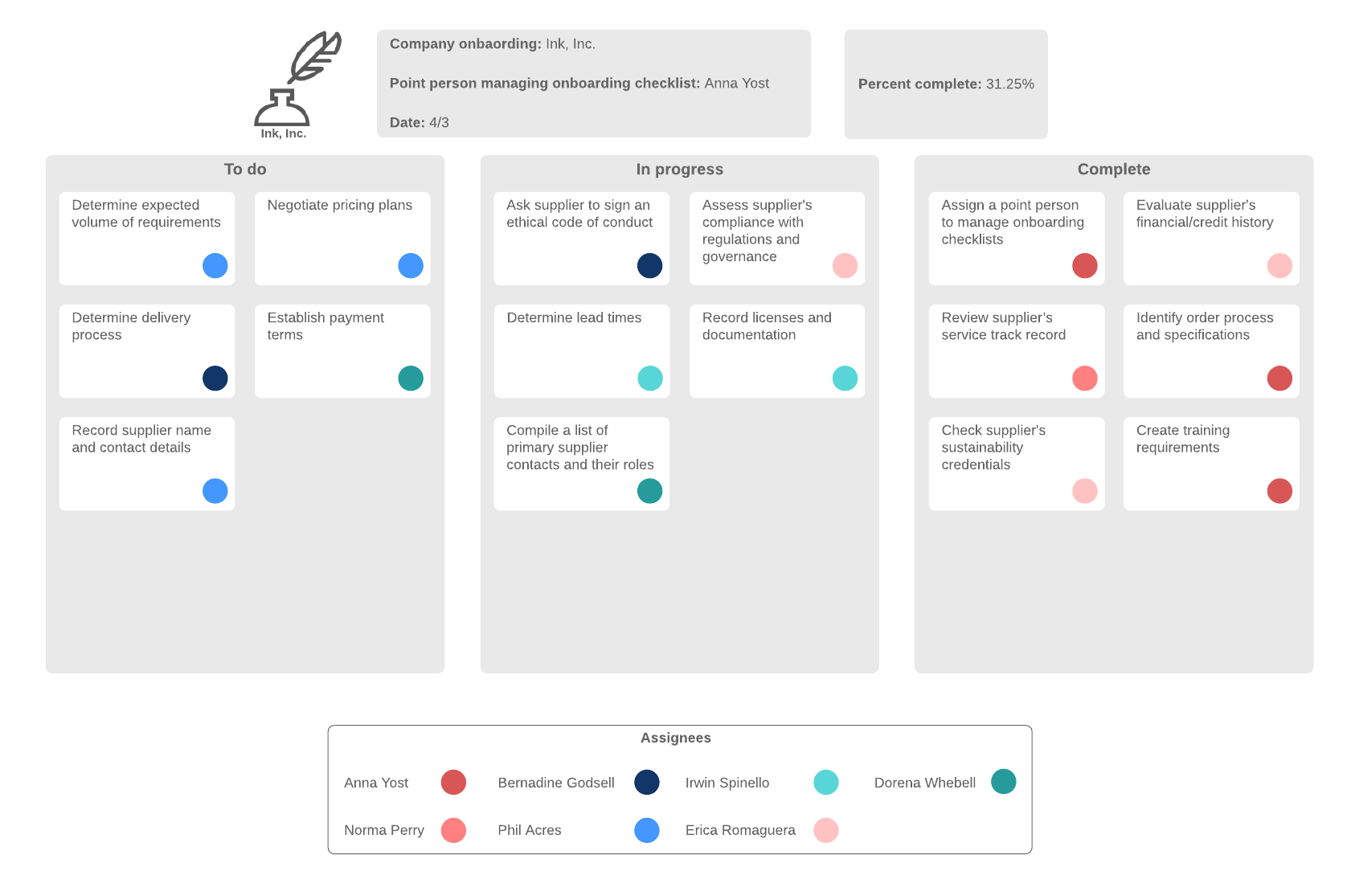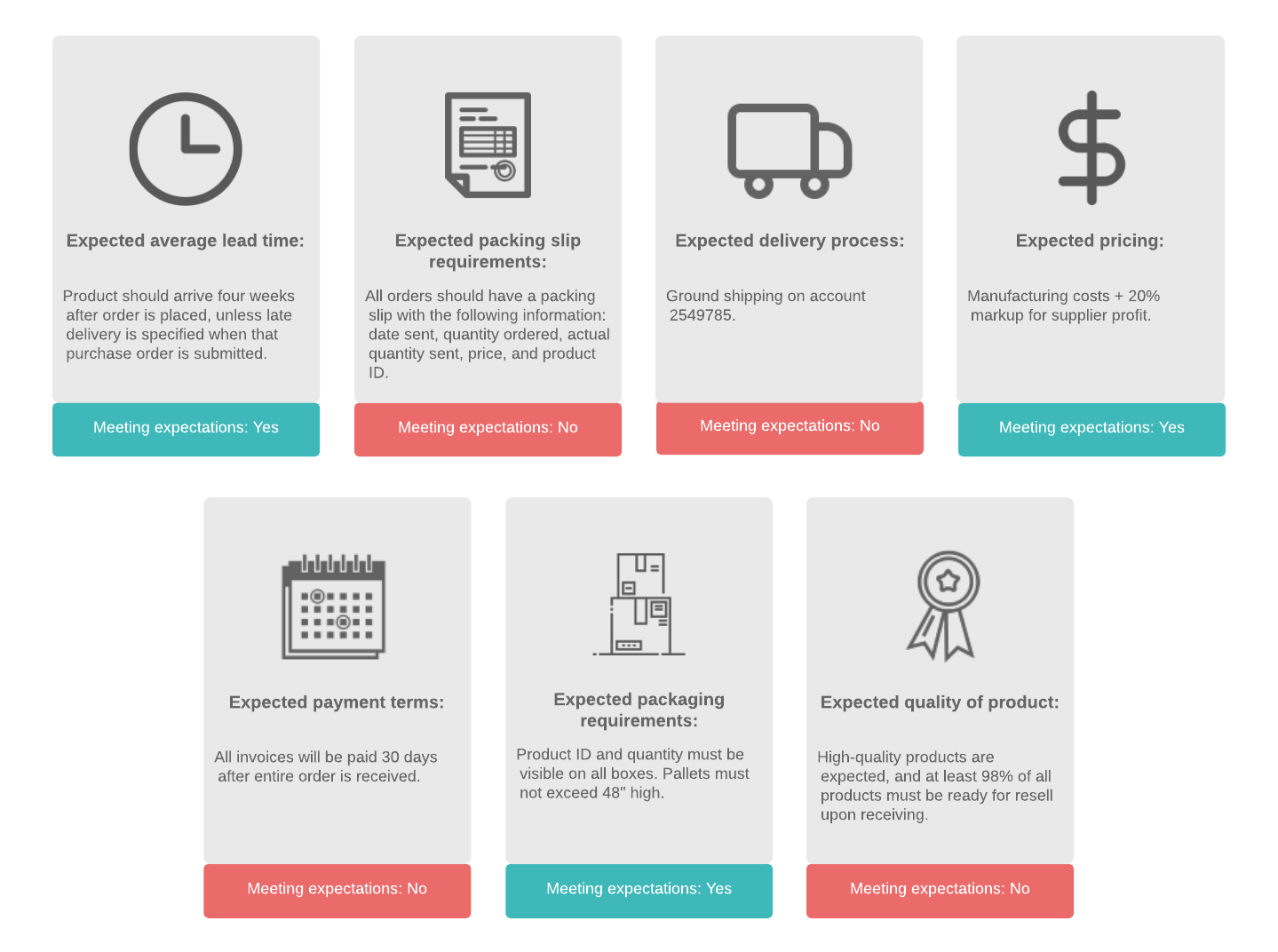
How to develop a successful supplier onboarding process
Lucid Content
Reading time: about 7 min
Topics:
Navigating new supplier relationships can be complex. Without a clear system in place to onboard and develop those partnerships, you risk losing valuable business and sacrificing profit margins.
Onboarding your suppliers before you start working together helps both parties set off on the right foot. Here’s how.

What is supplier onboarding?
Supplier onboarding is the process of collecting prospective vendor information, assessing vendor compliance and risks, and integrating them to your platform and supply chain. Put simply, supplier onboarding is about creating streamlined processes to build stronger buyer-vendor relationships that result in improved business outcomes for both parties.
How to create a supplier onboarding process
A robust supplier onboarding process will actually consist of several separate processes to move the supplier relationship through each stage of the onboarding program.
Below are the main steps you’ll need to take to develop an onboarding process from supplier consideration to approved partner.
1. Create an evaluation and approval process
When building your onboarding program, you’ll first need to establish supplier evaluation and approval policies. In other words, determine the guiding parameters for who you will and will not work with, and figure out the steps your team and the prospective vendors must take to move through the approval process.
2. Establish requirements and expectations
In a similar vein, you’ll next have to outline your business requirements and expectations for the working relationship.
Creating clear-cut policies and vendor requirements will not only help your business managers and other stakeholders quickly vet and approve appropriate suppliers, but they will ensure both you and the supplier understand what is expected. Clear policies and expectations will increase efficiency and reduce confusion and potential friction.
3. Create a vendor portal for registration and data collection
If you don’t have one already, set up a vendor portal for prospective suppliers to register and apply to work with you.
The portal should have a form for the vendor to fill out contact information and other details that will help your team quickly vet the proposal. This improves the accuracy of your data and streamlines the info gathering process.
4. Develop a process for strategic supplier partnerships
Strategic suppliers are those vendors who have a more significant impact on the business. Typically they represent a larger proportion of spend compared to other vendors and may have other strategic value for the business.
Because of their significant impact and value to the business, it makes sense to create a separate onboarding process for these vendors. A cross-functional committee may want to weigh in and help nurture those partnerships throughout the onboarding program.
5. Establish a system and culture of communication
Finally, the most successful onboarding programs are built on a culture of communication. But good communication doesn’t happen in a vacuum.
As you develop your onboarding processes, keep communication front of mind. Your processes should make it easy for different departments and stakeholders to share and access vendor data so that all parties are acting on the best information.
This step will improve efficiency across the board, mitigate risks of costly delays or mistakes, and promote positive relationships with your suppliers.

Vendor onboarding checklist
Each business and vendor partnership is different, but it helps to have a basic checklist to walk through for each potential relationship. Use the following supplier onboarding checklist as a guideline.
Evaluation
The first onboarding stage consists of vendor evaluation and risk assessment:
- Review supplier’s service track record.
- Check their sustainability credential.
- Evaluate their financial/credit history.
- Assess their compliance with regulations and governance.
- Ask them to sign an ethical code of conduct.
Vendor approval and requirements
The approval process is the time to qualify your suppliers and ensure both parties are on the same page before moving forward. Discuss the following to clarify expectations and requirements before finalizing approvals:
- Expected volume of requirements
- Lead times
- Pricing plans
- Payment terms
- Order process and specifications
- Delivery process
- Training requirements
Strategic supplier partnerships may require a more deliberate onboarding approach to carefully nurture and develop those relationships. These types of suppliers need more than a basic checklist.
Instead, consider implementing an onboarding council that is dedicated to nurturing those leads and addressing each vendor more strategically.
Supplier info and data sharing
The easiest way to gather supplier data accurately and consistently is to create an online vendor application portal where each supplier can input their information themselves.
Depending on how in-depth your form is, you may need to follow up with the supplier to verify additional information. Be sure to gather the following data for each vendor:
- Supplier name and contact details
- Licenses and documentation
- List of primary supplier contacts and their roles
Once you have gathered all necessary data, be sure to share it with all involved stakeholders. Clear communication of accurate information is critical for a smooth supplier onboarding and activation process.
Make sure your accounts, purchasing, and warehouse managers have the supplier details and requirements and then share a finalized approval contract for the vendor to review before activation. This way, all departments and stakeholders will be on the same page and clear on the expectations and terms.
This is also the time to provide any needed training or clarify questions and concerns regarding the supply process or other business administration.
Onboarding best practices
As you develop your onboarding process, follow these best practices:
- Assign a point person to manage onboarding checklists. With so many requirements and process steps, it’s easy for things to get lost in the shuffle. To avoid mistakes or miscommunication, designate one person to be responsible for verifying each item on your checklist(s).
- Automate processes where possible. Onboarding a new supplier can be a complex (and sometimes tedious) process. Look for opportunities to automate tasks to increase efficiency and reduce human error.
- Use the onboarding process as a guideline. Each supplier is different. Be flexible and use your onboarding plan as a guideline that adapts to each unique relationship.
- Create a plan for each vendor and follow up. Within your onboarding process, you should create an individualized plan for each vendor partnership that outlines your strategy for growth and steps to achieve it. Then follow up on those plans to ensure you are getting the most value from that relationship.
- Set expectations. Make sure that suppliers understand the expectations for lead time, pricing, payment, product quality, and other factors. In Lucidchart, you can even link data to a document and apply conditional formatting to create a dashboard showing whether or not expectations have been met.

Basic onboarding process example
Depending on your business parameters and specific onboarding needs, your processes may vary. However, you can use the following onboarding process example to get started.

Why you need a supplier onboarding process
Good business is built on good relationships. And that doesn’t only apply to clients and customers. Just as you should nurture and support your client relationships, you should nurture your vendor and supplier relationships.
A supplier onboarding process is the foundation of a strong supplier base management program and is the first step to building those crucial business partnerships with your suppliers.
Not only will a vendor onboarding process strengthen your business relationships, but it will also help your organization to:
- Mitigate risks.
- Streamline processes and increase efficiency.
- Ensure compliance with regulations.
- Develop a positive reputation in the industry.
- Increase ROI.
- Reduce redundancies.
- Track data and workflow.
- Automate basic tasks.
- Reduce time to approve and activate new suppliers.
- Cut out middlemen and reduce human error.
Without a good onboarding process, at best you may face reduced productivity and efficiency and at worst you risk losing valuable business due to poor training, management, or partner nurturing.
Using Lucidchart to streamline your onboarding process
Building and tracking your onboarding process is a big undertaking. Keep everyone on the same page with Lucidchart.
Lucidchart is a cloud-based diagramming solution that helps businesses design and visualize their processes from start to finish. Use Lucidchart to document your onboarding and approval checklists, map out your onboarding process, and create data visualizations or org charts to support your supplier training resources.
With ready-made templates, intuitive design, and simple sharing options, you can make sure nothing falls through the cracks.
Sign up for freeAbout Lucidchart
Lucidchart, a cloud-based intelligent diagramming application, is a core component of Lucid Software's Visual Collaboration Suite. This intuitive, cloud-based solution empowers teams to collaborate in real-time to build flowcharts, mockups, UML diagrams, customer journey maps, and more. Lucidchart propels teams forward to build the future faster. Lucid is proud to serve top businesses around the world, including customers such as Google, GE, and NBC Universal, and 99% of the Fortune 500. Lucid partners with industry leaders, including Google, Atlassian, and Microsoft. Since its founding, Lucid has received numerous awards for its products, business, and workplace culture. For more information, visit lucidchart.com.
Related articles
Keep Your request for proposal (RFP) process on track
When your business requires work from outside companies, the success of your company depends on your RFP process. Refine yours today!
New hire employee onboarding process
Learn how implementing a strategic onboarding process at your company can help increase new hire productivity and employee retention.
